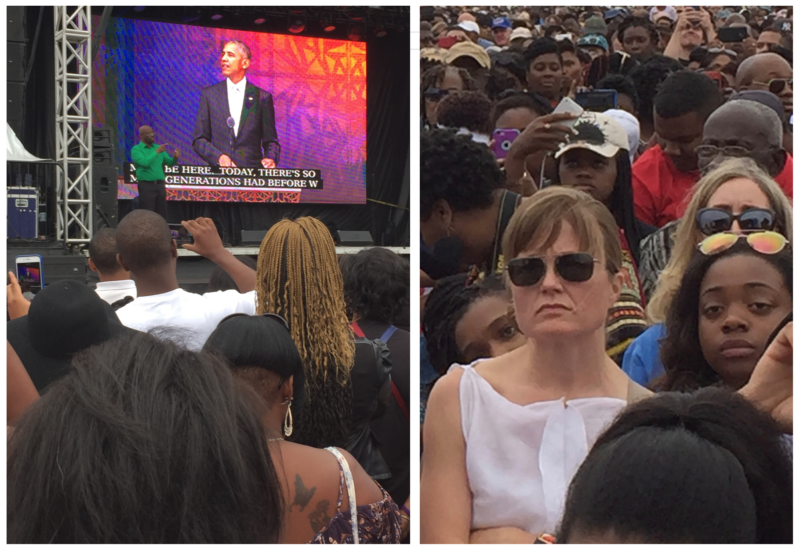After 100 Years Of Challenges, The 1st National Black History Museum Is Here
Share
Breaking News!
Today's news and culture by Black and other reporters in the Black and mainstream media.
Ways to Support ABHM?
“Nothing has been easy. Everything has had to be earned."
Black history is finally taking its rightful place within the Smithsonian Institution with the National Museum of African American History and Culture’s grand opening on Saturday.
While the museum is now opening to considerable fanfare ― the ceremony includes a three-day festival and a dedication led by President Barack Obama to mark the historic occasion ― getting the project off the ground was anything but easy.
A group of black Civil War veterans first advocated for the idea of a national African-American history museum in the early 1900s. Decades later, a group of congressmen led by civil rights icon Rep. John Lewis (D-Ga.) took the fight for the museum to Capitol Hill. Lewis introduced legislation to fund the museum every year for 15 years, but it was defeated every time.
Sen. Cory Booker (D-N.J.) said the museum faced plenty of challenges, from “overt bigotry” to “lack of prioritization.”
“In many ways, it itself is reminiscent or reflective of the African-American experience. Nothing has been easy. Everything has had to be earned,” he said.
Some representatives who opposed the museum said the project was too costly. Others, like Sen. Jesse Helms (R-N.C.), warned the museum would set a dangerous precedent and open the floodgates for additional museums dedicated to other racial minorities. “Every other minority will give thought to asking the taxpayers to pony up for a special museum for them,” Helms said in 1994.

Dr. Lonnie G. Bunch III, the visionary first director of the NMAAHC, worked tirelessly for over a decade to bring this new national treasure into existence.
In 2001, President George Bush created a commission to explore the need for the museum and develop a plan of action. After much debate over the location for the museum, the National Museum of African American History and Culture Act was finally signed into law in 2003, establishing the 19th Smithsonian museum. But the project still faced another hurdle: funding. It would ultimately cost $540 million and the federal government was only going to cover half.
Dr. Lonnie Bunch, NMAAHC's first Director,* said the funding situation was “unusual.” According to The New York Times, government funds have covered all or most of the building costs for every other Smithsonian museum.
Organizations including the Oprah Winfrey Charitable Foundation and the Bill & Melinda Gates Foundation contributed millions to the project. The museum also found support from the black community. According to The Washington Post, 74 percent of individuals who donated $1 million or more to the project were African-American.
The museum’s three-tiered building, which sits on the National Mall alongside the Washington Monument, is inspired by Yoruban caryatid ― a slender wooden column with a crown at the top. The museum is filled with everything from historical artifacts of the days of slavery to pop culture relics.
“In essence what you will find in this museum is a tension. A tension between difficult moments and a tension between moments that are full of happiness hope and resiliency,” Bunch said.
And with Obama’s dedication on Saturday, the journey for the museum has truly come full circle. Booker said the presence of the first black president coupled with the museum’s opening will mark “spiritual culmination” of sorts.
“I mean these two moments in history have met up in a beautiful way, almost as if it were sort of ordained by the spirits, like the heavens are sort of rejoicing,” he said. “I just think it’s a wonderful exclamation point on the journey of this museum.
* In June 2019, Dr. Bunch was promoted to Secretary of the Smithsonian Institution. As the head of this enormous and highly respected national institution, he oversees 19 museums, 21 libraries, the National Zoo, numerous research centers, and several education units and centers.
Take a virtual tour of the new National Museum of African American History and Culture.
Watch the full Dedication Ceremony.











Comments Are Welcome
Note: We moderate submissions in order to create a space for meaningful dialogue, a space where museum visitors – adults and youth –– can exchange informed, thoughtful, and relevant comments that add value to our exhibits.
Racial slurs, personal attacks, obscenity, profanity, and SHOUTING do not meet the above standard. Such comments are posted in the exhibit Hateful Speech. Commercial promotions, impersonations, and incoherent comments likewise fail to meet our goals, so will not be posted. Submissions longer than 120 words will be shortened.
See our full Comments Policy here.